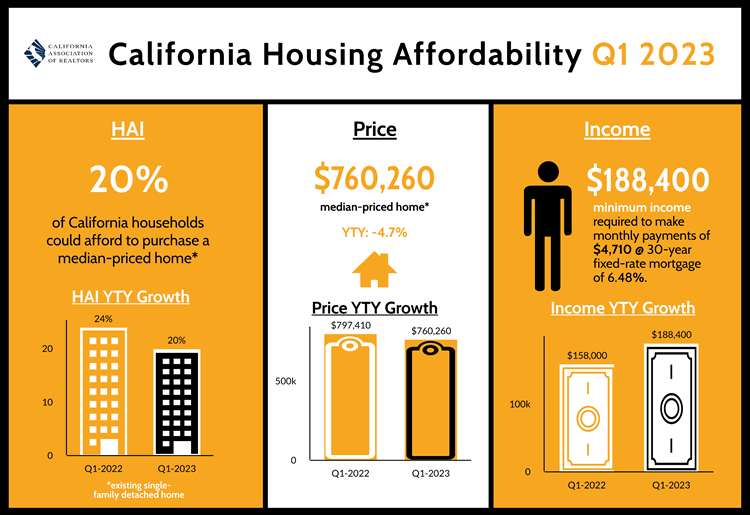
|
California Housing Affordability Rises to Highest Level in a Year
LOS ANGELES (May 16) – Retreating home prices and slightly lower interest rates improved the outlook for more California homebuyers in the first quarter of 2023, as the state’s housing affordability rose to the highest level in a year, the CALIFORNIA ASSOCIATION OF REALTORS (C.A.R.) said today. Looking ahead, C.A.R. also announced it has revised its 2023 Housing Market Forecast and projects existing single-family home sales to reach 279,900 units in 2023, a decline of 18.2 percent from the 342,000 units sold in 2022. While home prices in general are expected to improve in the second half of the year, the California median home price is projected to decrease 5.6 percent to $776,600 in 2023, down from the annual median price of $822,300 recorded in 2022. The updated projection on the statewide median price, however, is an increase from the estimate of $758,600 forecast last October. C.A.R. also projects the 30-year fixed mortgage interest rate to average 6.3 percent for the year. One in five homebuyers could afford to purchase a median-priced, existing single-family home in California in first-quarter 2023, up from 17 percent in the fourth quarter of 2022 and down from 24 percent in the first quarter of 2022, according to C.A.R.’s Traditional Housing Affordability Index (HAI). The first-quarter 2023 figure is less than half of the affordability index peak of 56 percent in the first quarter of 2012. With interest rates near the highest level in the past 16 years, housing affordability will remain a challenge for many homebuyers in the coming quarters. C.A.R.’s HAI measures the percentage of all households that can afford to purchase a median-priced, single-family home in California. C.A.R. also reports affordability indices for regions and select counties within the state. The index is considered the most fundamental measure of housing well-being for home buyers in the state. A minimum annual income of $188,400 was needed to qualify for the purchase of a $760,260 statewide median-priced, existing single-family home in the first quarter of 2023. The monthly payment, including taxes and insurance (PITI) on a 30-year, fixed-rate loan, would be $4,710, assuming a 20 percent down payment and an effective composite interest rate of 6.48 percent. The effective composite interest rate was 6.81 percent in fourth-quarter 2022 and 3.97 percent in first-quarter 2022. Interest rates are expected to remain elevated for the rest of the year as inflation continues to stay above the Federal Reserve’s target range, which will continue to put pressure on affordability in the coming quarters. The median price of condominiums and townhomes in California slipped from a year ago but inched up from the previous quarter. As a result, the share of households that could afford a typical condo/townhome in first-quarter 2023 was unchanged from the 26 percent recorded in the previous quarter but fell from the 32 percent recorded in the first quarter of 2022. An annual income of $153,600 was required to make the monthly payment of $3,840 on the $619,900 median-priced condo/townhome in the first quarter of 2023. Compared with California, four in 10 of the nation’s households could afford to purchase a $371,200 median-priced home, which required a minimum annual income of $92,000 to make monthly payments of $2,300. Nationwide affordability was down from 47 percent a year ago. Key points from the first-quarter 2023 Housing Affordability report include:
|
| © 2006 - 2022. All Rights Reserved. |
